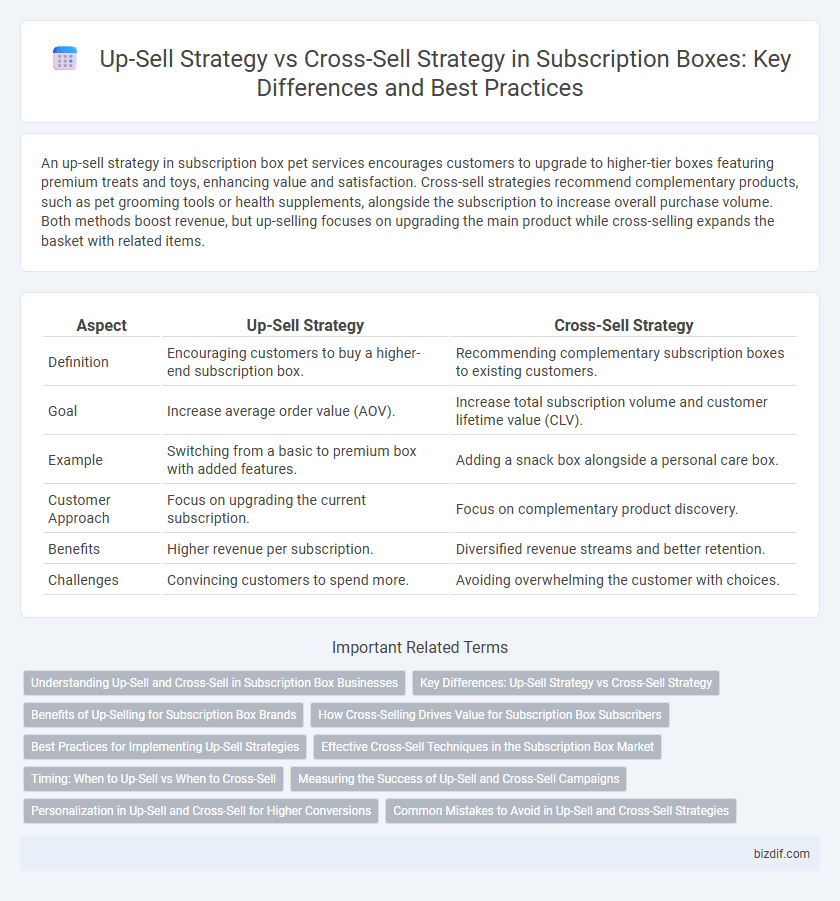An up-sell strategy in subscription box pet services encourages customers to upgrade to higher-tier boxes featuring premium treats and toys, enhancing value and satisfaction. Cross-sell strategies recommend complementary products, such as pet grooming tools or health supplements, alongside the subscription to increase overall purchase volume. Both methods boost revenue, but up-selling focuses on upgrading the main product while cross-selling expands the basket with related items.
Table of Comparison
| Aspect | Up-Sell Strategy | Cross-Sell Strategy |
|---|---|---|
| Definition | Encouraging customers to buy a higher-end subscription box. | Recommending complementary subscription boxes to existing customers. |
| Goal | Increase average order value (AOV). | Increase total subscription volume and customer lifetime value (CLV). |
| Example | Switching from a basic to premium box with added features. | Adding a snack box alongside a personal care box. |
| Customer Approach | Focus on upgrading the current subscription. | Focus on complementary product discovery. |
| Benefits | Higher revenue per subscription. | Diversified revenue streams and better retention. |
| Challenges | Convincing customers to spend more. | Avoiding overwhelming the customer with choices. |
Understanding Up-Sell and Cross-Sell in Subscription Box Businesses
Up-sell strategy in subscription box businesses involves encouraging customers to purchase a higher-tier plan or premium products within the same subscription category, increasing the average order value and enhancing customer experience. Cross-sell strategy targets adding complementary or related products outside the primary subscription, expanding the product range and boosting overall revenue streams. Understanding these strategies enables subscription box companies to tailor offers that meet diverse customer needs while maximizing lifetime value.
Key Differences: Up-Sell Strategy vs Cross-Sell Strategy
Up-sell strategy in subscription boxes aims to encourage customers to upgrade to a higher-tier or premium plan with enhanced features or exclusive items, boosting average revenue per user (ARPU). Cross-sell strategy focuses on offering complementary products or add-ons that enhance the subscriber's experience, increasing overall cart value without changing the existing subscription tier. Key differences lie in up-sell targeting higher value subscriptions, while cross-sell promotes additional, related products to maximize customer lifetime value (CLV).
Benefits of Up-Selling for Subscription Box Brands
Up-selling in subscription box brands increases average order value by encouraging customers to purchase higher-tier plans or premium add-ons, enhancing revenue and customer lifetime value. This strategy deepens customer engagement by offering exclusive, upgraded products that match user preferences, promoting brand loyalty and satisfaction. By shifting focus to up-sell, subscription box companies can optimize profit margins and deliver more personalized experiences, driving sustainable business growth.
How Cross-Selling Drives Value for Subscription Box Subscribers
Cross-selling in subscription boxes enhances subscriber value by offering complementary products tailored to their preferences, increasing overall satisfaction and engagement. By suggesting related items alongside the main subscription, brands boost average order value and foster a personalized shopping experience. This targeted approach strengthens customer loyalty and encourages repeat purchases within the subscription ecosystem.
Best Practices for Implementing Up-Sell Strategies
Effective up-sell strategies in subscription box services prioritize personalized product recommendations based on customer preferences and purchase history, increasing average order value while enhancing customer satisfaction. Utilizing data analytics to identify high-value items and strategically offering premium variants or add-ons during the checkout process maximizes conversion rates. Clear communication of added benefits, exclusivity, and limited-time offers drives urgency and encourages customers to upgrade their subscription tiers or box contents.
Effective Cross-Sell Techniques in the Subscription Box Market
Effective cross-sell techniques in the subscription box market involve recommending complementary products that enhance the core subscription experience, such as offering matching accessories or exclusive add-ons tailored to the subscriber's preferences. Personalization algorithms and data analytics play a crucial role in identifying relevant items that increase average order value without overwhelming the customer. Brands leveraging these strategies report higher retention rates and increased lifetime customer value compared to relying solely on up-sell tactics.
Timing: When to Up-Sell vs When to Cross-Sell
Up-sell strategies are most effective during the purchase decision phase, encouraging customers to choose a higher-tier subscription box or add premium options before completing the order. Cross-sell strategies work best post-purchase, offering complementary products or extras that enhance the current subscription experience without disrupting the primary transaction. Timing these approaches correctly increases customer satisfaction and maximizes average order value in subscription box services.
Measuring the Success of Up-Sell and Cross-Sell Campaigns
Measuring the success of up-sell and cross-sell campaigns in subscription boxes involves analyzing key performance indicators such as average order value (AOV), customer lifetime value (CLV), and conversion rates. Tracking the incremental revenue generated from up-sell offers, such as premium subscription tiers, alongside the effectiveness of cross-sell promotions featuring complementary products, provides actionable insights into campaign performance. Utilizing customer segmentation and purchase behavior data enhances the precision of these metrics, enabling targeted optimization for maximizing profitability.
Personalization in Up-Sell and Cross-Sell for Higher Conversions
Personalization in up-sell and cross-sell strategies significantly boosts subscription box conversions by tailoring offers to individual customer preferences and purchase history. Up-sell tactics focus on enhancing the core subscription with premium options or exclusive add-ons that match user profiles, while cross-sell strategies recommend complementary products that align with subscriber interests. Leveraging data-driven personalization increases relevance, driving higher engagement, satisfaction, and lifetime value for subscription services.
Common Mistakes to Avoid in Up-Sell and Cross-Sell Strategies
Common mistakes in up-sell and cross-sell strategies for subscription boxes include pushing irrelevant or overly expensive products that do not align with customer preferences, leading to lower conversion rates. Ignoring personalized data and purchasing behavior results in generic offers that customers perceive as spammy or intrusive. Failing to clearly communicate the added value and benefits of the recommended items often causes disengagement and missed revenue opportunities.
up-sell strategy vs cross-sell strategy Infographic

 bizdif.com
bizdif.com